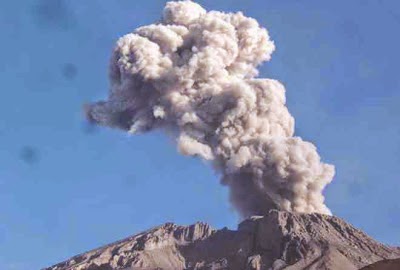Mount Urbinas, a small but highly active volcano in the southern Peruvian Andes, generally considered to be Peru's most active volcano, erupted at 7.42 am local time (1.42 pm GMT) on Monday 31 March 2014, according to the Geophysical Institute of Arequipa, producing an ash column rising 1000 m above the volcano's summit, and leading to the evacuation of the village of Querapi, which is 5 km from Urbinas. The volcano began to show signs of activity in September 2013, after several years of inactivity, but this is the first major eruption since then.
The ash column above Urbinas as seen at 7.44 am local time on 31 March 2014. Observatorio vulcanológico del Ingemmet.
The volcanoes of the Peruvian Andes, and of South America in general, are fueled by the subduction of the Nazca Plate beneath the South American Plate. The Nazca Plate underlies a large chunk of the eastern Pacific Ocean, and is being subducted along Peru-Chile Trench to the west of South America. As it sinks into the Earth, the Nazca Plate passes under South America, where it is heated by friction with the overlying South American Plate and by the heat of the planet's interior. This causes the Nazca Plate to partially melt, and some of this melted material then rises through the South American Plate as magma, fueling the volcanoes of the Andes. The motion of one plate beneath another is not a smooth process, and the Nazca and South American Plates frequently stick together, then break apart as the pressure builds up, triggering frequent Earthquakes along the western coast of South America, and sometimes further inland.
The approximate location of Mount Urbinas. Google Maps.
See also
Follow Sciency Thoughts on Facebook.





